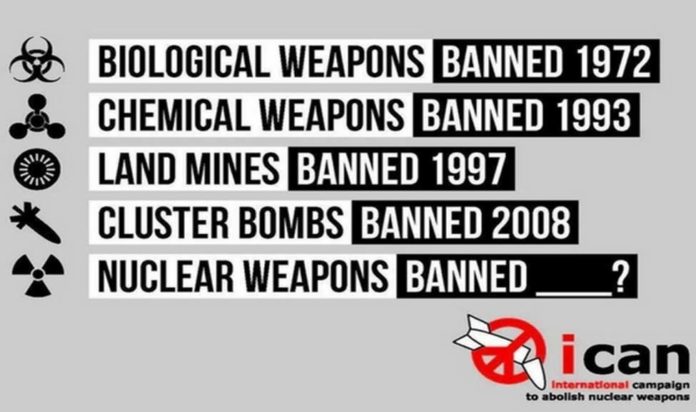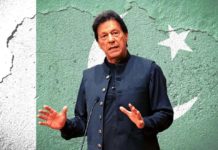On March 27, the United Nations will start negotiations on an international treaty to ban nuclear weapons. The nuclear weapon states will finally be put to the test: Will they keep their promises to disarm and join the treaty, or will they reject international law and the will of the global community?
PRINCETON – On March 27, the United Nations will start negotiations on an international treaty to ban nuclear weapons. It will be a milestone marking the beginning of the end of an age of existential peril for humanity.
This day was bound to come. From the beginning, even those who set the world on the path to nuclear weapons understood the mortal danger and moral challenge confronting humanity. In April 1945, US Secretary of War Henry Stimson explained to President Harry Truman that the atomic bomb would be “the most terrible weapon ever known in human history.” Stimson warned that “the world in its present state of moral advancement compared with its technical development would be eventually at the mercy of such a weapon. In other words, modern civilization might be completely destroyed.”
Soon afterwards, the newly created UN, established with the express purpose “to save succeeding generations from the scourge of war,” took the threat posed by nuclear arms as its first priority. In January 1946, in its very first resolution, the UN calledfor a plan “for the elimination from national armaments of atomic weapons.”
The Soviet Union submitted such a plan that June. Now largely forgotten, the Gromyko Plan included a “Draft International Convention to Prohibit the Production and Employment of Weapons Based on the Use of Atomic Energy for the Purpose of Mass Destruction.” At the time, only the United States had nuclear weapons, and it chose to maintain its monopoly. But it couldn’t hold onto it for long. Where it led, others soon followed, forcing humanity to endure the decades of weapons development, arms races, proliferation, and nuclear crises that followed.
Anti-nuclear movements took root, and, in a phrase made famous by the historian E.P. Thompson, began to protest to survive. They found allies in a growing number of countries. In November 1961, the UN General Assembly declared that “any state using nuclear and thermonuclear weapons is to be considered as violating the Charter of the United Nations, as acting contrary to the laws of humanity, and as committing a crime against mankind and civilization.”
As the number and destructive power of nuclear weapons grew, and as even developing countries began to acquire them, recognition of the danger gave rise to the Nuclear Non-Proliferation Treaty, which entered into force in 1970. “Considering the devastation that would be visited upon all mankind by a nuclear war,” the NPT begins, there is a “consequent need to make every effort to avert the danger of such a war and to take measures to safeguard the security of peoples.”
To this end, the treaty committed all signatories to “undertake negotiations in good faith on effective measures relating to cessation of the nuclear arms race at an early date and to nuclear disarmament.” The US, the Soviet Union, and Britain signed the NPT. France and China, the only other nuclear weapon states at the time, held out for more than 20 years, until 1992. Israel, India, and Pakistan have never signed, while North Korea signed and then withdrew. Although all professed support for achieving a nuclear-weapon-free world, disarmament negotiations never began.
Countries without nuclear weapons – the overwhelming majority – took matter into their own hands. Through the UN General Assembly, they asked the International Court of Justice to rule on the legality of the threat or use of nuclear weapons. In July 1996, the ICJ issued an advisory opinion, with two key conclusions. First, “the threat or use of nuclear weapons would generally be contrary to the rules of international law applicable in armed conflict, and in particular the principles and rules of humanitarian law.” And, second, “There exists an obligation to pursue in good faith and bring to a conclusion negotiations leading to nuclear disarmament in all its aspects under strict and effective international control.”
But, in the 20 years since the highest court in the international system issued its judgment, the states affected by it have still failed to launch “negotiations leading to nuclear disarmament.” Instead, they have set out on long-term programs to maintain, modernize, and in some cases augment their nuclear arsenals.
Non-weapon states began to take action through a series of international conferences and UN resolutions. Finally, in October 2016, the UN General Assembly’s First Committee, which is responsible for international peace and security, voted “to convene in 2017 a United Nations conference to negotiate a legally binding instrument to prohibit nuclear weapons, leading towards their total elimination.” On December 23, the General Assembly ratified the decision, with 113 countries in favor, 35 opposed, and 13 abstentions.
The new resolution’s instructions are straightforward: “States participating in the conference” should “make their best endeavors to conclude as soon as possible a legally binding instrument to prohibit nuclear weapons, leading towards their total elimination.” The treaty could be ready before the end of the year.
The nine nuclear weapon states will finally be put to the test. Will they keep their promises to disarm and join the treaty, or will they choose their weapons over international law and the will of the global community? The non-weapon states that join the treaty will be tested, too. How will they organize to confront those countries in the world system that choose to be nuclear outlaws?
About the Author:
Zia Mian is co-director of the Program on Science and Global Security at the Woodrow Wilson School of Public and International Affairs, Princeton University. M.V. Ramana is the Simons Chair in Disarmament, Global and Human Security with the Liu Institute for Global Issues at the University of British Columbia.








PRINCETON – On March 27, the United Nations will start negotiations on an international treaty to ban nuclear weapons. It will be a milestone marking the beginning of the end of an age of existential peril for humanity.
This day was bound to come. From the beginning, even those who set the world on the path to nuclear weapons understood the mortal danger and moral challenge confronting humanity. In April 1945, US Secretary of War Henry Stimson explained to President Harry Truman that the atomic bomb would be “the most terrible weapon ever known in human history.” Stimson warned that “the world in its present state of moral advancement compared with its technical development would be eventually at the mercy of such a weapon. In other words, modern civilization might be completely destroyed.”
Soon afterwards, the newly created UN, established with the express purpose “to save succeeding generations from the scourge of war,” took the threat posed by nuclear arms as its first priority. In January 1946, in its very first resolution, the UN calledfor a plan “for the elimination from national armaments of atomic weapons.”
The Soviet Union submitted such a plan that June. Now largely forgotten, the Gromyko Plan included a “Draft International Convention to Prohibit the Production and Employment of Weapons Based on the Use of Atomic Energy for the Purpose of Mass Destruction.” At the time, only the United States had nuclear weapons, and it chose to maintain its monopoly. But it couldn’t hold onto it for long. Where it led, others soon followed, forcing humanity to endure the decades of weapons development, arms races, proliferation, and nuclear crises that followed.
Anti-nuclear movements took root, and, in a phrase made famous by the historian E.P. Thompson, began to protest to survive. They found allies in a growing number of countries. In November 1961, the UN General Assembly declared that “any state using nuclear and thermonuclear weapons is to be considered as violating the Charter of the United Nations, as acting contrary to the laws of humanity, and as committing a crime against mankind and civilization.”
As the number and destructive power of nuclear weapons grew, and as even developing countries began to acquire them, recognition of the danger gave rise to the Nuclear Non-Proliferation Treaty, which entered into force in 1970. “Considering the devastation that would be visited upon all mankind by a nuclear war,” the NPT begins, there is a “consequent need to make every effort to avert the danger of such a war and to take measures to safeguard the security of peoples.”
To this end, the treaty committed all signatories to “undertake negotiations in good faith on effective measures relating to cessation of the nuclear arms race at an early date and to nuclear disarmament.” The US, the Soviet Union, and Britain signed the NPT. France and China, the only other nuclear weapon states at the time, held out for more than 20 years, until 1992. Israel, India, and Pakistan have never signed, while North Korea signed and then withdrew. Although all professed support for achieving a nuclear-weapon-free world, disarmament negotiations never began.
Countries without nuclear weapons – the overwhelming majority – took matter into their own hands. Through the UN General Assembly, they asked the International Court of Justice to rule on the legality of the threat or use of nuclear weapons. In July 1996, the ICJ issued an advisory opinion, with two key conclusions. First, “the threat or use of nuclear weapons would generally be contrary to the rules of international law applicable in armed conflict, and in particular the principles and rules of humanitarian law.” And, second, “There exists an obligation to pursue in good faith and bring to a conclusion negotiations leading to nuclear disarmament in all its aspects under strict and effective international control.”
But, in the 20 years since the highest court in the international system issued its judgment, the states affected by it have still failed to launch “negotiations leading to nuclear disarmament.” Instead, they have set out on long-term programs to maintain, modernize, and in some cases augment their nuclear arsenals.
Non-weapon states began to take action through a series of international conferences and UN resolutions. Finally, in October 2016, the UN General Assembly’s First Committee, which is responsible for international peace and security, voted “to convene in 2017 a United Nations conference to negotiate a legally binding instrument to prohibit nuclear weapons, leading towards their total elimination.” On December 23, the General Assembly ratified the decision, with 113 countries in favor, 35 opposed, and 13 abstentions.
The new resolution’s instructions are straightforward: “States participating in the conference” should “make their best endeavors to conclude as soon as possible a legally binding instrument to prohibit nuclear weapons, leading towards their total elimination.” The treaty could be ready before the end of the year.
The nine nuclear weapon states will finally be put to the test. Will they keep their promises to disarm and join the treaty, or will they choose their weapons over international law and the will of the global community? The non-weapon states that join the treaty will be tested, too. How will they organize to confront those countries in the world system that choose to be nuclear outlaws?
Source: Project Syndicate
About the Author:
Zia Mian is co-director of the Program on Science and Global Security at the Woodrow Wilson School of Public and International Affairs, Princeton University. M.V. Ramana is the Simons Chair in Disarmament, Global and Human Security with the Liu Institute for Global Issues at the University of British Columbia.